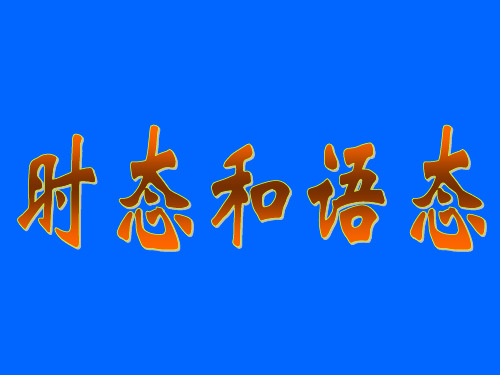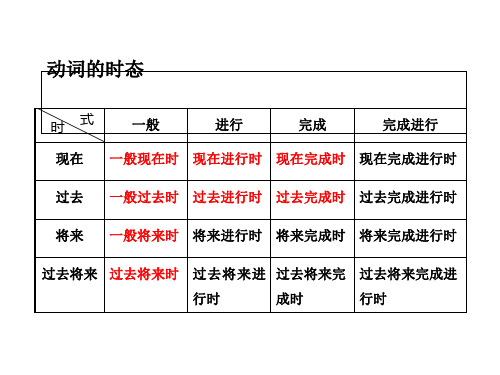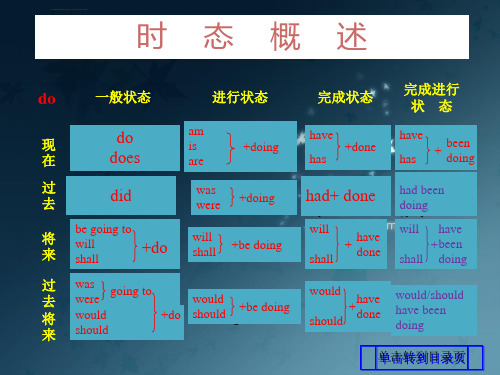英语时态课件整合
合集下载
英语时态8种基本时态讲解.ppt课件

4)动词过去式变化规则。 a)一般情况下的词加-ed. work---worked call----called b)以不发音的字母e结尾的单词直接加-d . live----lived change----changed smoke----smoked die----died graduate----graduated drive----drove
8.过去完成时 表示动作发生在过去某一时间之前已经完成的动作或状态, 强调“过去的过去”, 常与 by the time, by the end of…,before , by 等引导时间的状语连用。
基本结构 主语+ had + 动词过去分词 + 其他成分 When I got to the cinema yesterday the film had begun already. He had learned English before he came here.
现在完成时与一般过去时的区别: 1)现在完成时侧重于对现在的影响;而一般过去时侧重于某一动作发生在过去某个时间或某段时间。即现在完成时侧重于现在的结果,而一般过去时侧重于动作发生的时间。例如:
I have seen the film. 我看过这部电影。(现在我仍记得电影的内容) I saw the film three days ago. 三天前我看了这部电影。(强调是三天前,而不是别的什么时候看的电影)
be going to含有“打算,准备”的意思,而will则没有这个意思, She is going to lend us her book. He will be here in half an hour.
be about to+V.原形(意为马上做某事,在时间上指最近的将来) I am about to leave school. 不能与表示时间的副词连用。 They are about to set out.(√) They are about to set,变y为i加-ed. study----studied carry----carried cry----cried try----tried d)以元音字母+y结尾的单词直接加-ed. play----played stay----stayed
8.过去完成时 表示动作发生在过去某一时间之前已经完成的动作或状态, 强调“过去的过去”, 常与 by the time, by the end of…,before , by 等引导时间的状语连用。
基本结构 主语+ had + 动词过去分词 + 其他成分 When I got to the cinema yesterday the film had begun already. He had learned English before he came here.
现在完成时与一般过去时的区别: 1)现在完成时侧重于对现在的影响;而一般过去时侧重于某一动作发生在过去某个时间或某段时间。即现在完成时侧重于现在的结果,而一般过去时侧重于动作发生的时间。例如:
I have seen the film. 我看过这部电影。(现在我仍记得电影的内容) I saw the film three days ago. 三天前我看了这部电影。(强调是三天前,而不是别的什么时候看的电影)
be going to含有“打算,准备”的意思,而will则没有这个意思, She is going to lend us her book. He will be here in half an hour.
be about to+V.原形(意为马上做某事,在时间上指最近的将来) I am about to leave school. 不能与表示时间的副词连用。 They are about to set out.(√) They are about to set,变y为i加-ed. study----studied carry----carried cry----cried try----tried d)以元音字母+y结尾的单词直接加-ed. play----played stay----stayed
初中英语六种时态复习课件(35张PPT)

②while 引导的从句表示“在……期间”,主从句谓语动词所表示的动 作同时ቤተ መጻሕፍቲ ባይዱ生。这时,主从句都用过去进行时。
e.g.:My father was reading the newspaper while my mother was watching TV.当我的妈妈看电视的时候,我的爸爸正在看报纸。
(2)表示普遍真理或客观事实。 e.g.:The sun rises in the east.太阳从东方升起。 (3)在条件状语从句和时间状语从句中,用一般现在时表示将来。 e.g.:If it doesn't rain tomorrow,we will go for a picnic.如果明天不下 雨,我们将去野餐。 (4)在某些以 here,there 开头的句子中用一般现在时表示正在发生的动作。 e.g.:There goes the bell.铃响了。
(3)现在进行时表示将来 表示位置移动的动词 go,come,leave,fly,start,meet,move 等, 可以用现在进行时表示将要发生的事。 e.g.:We are leaving for London.我们就要动身去伦敦了。
(4)一般现在时表示将来 ①表示按规定或时间表预计要发生的动作。 e.g.:Our plane takes off at 8:10.我们的飞机 8:10 起飞。 ②当主句为一般将来时,或含有情态动词,或是祈使句时,在 if,as soon as,until,when 等引导的状语从句中用一般现在时表示将来。 e.g.:I will give him the book as soon as he comes here.他一来这儿, 我就把这本书给他。
(2)表示当前一段时间内的活动或现阶段正在进行的动作。 e.g.:They are picking apples on a farm all the time.他们一直在农场 摘苹果。 (3)与 always,usually 等词连用,表达说话人强烈的感情,如赞扬、不 满、讨厌等。 e.g.:Mary is always thinking of others instead of herself.玛丽总是为 别人着想,而不为自己着想。
高中英语时态全版.ppt

Tom is seeing his friend off at the airport.
.精品课件.
16
过去进行时 表示过去某一时刻或某一段时间内正在进行 的动作。这一特定的过时间可用时间状语表 示
He was watching TV when I came in.
---What were you doing this time yesterday? ---I was writing a letter.
I will study hard to keep up with my classmates.
He won’t do it.
You shall have the book.
.精品课件.
8
2.be going to + 动词原形:含有打算、计划、 准备将做某事的意思,或表示很有可能要发 生的事。
3.若表示已安排或计划好的将来动作或存 在状态,可用一般现在时代替一般将来 时,其谓语动词常为be, come, go, arrive, leave, start等
Where shall we meet tomorrow?
.精品课件.
7
注:shall和will除了上述表示单纯的将来外, 还有其他用法。在第一人称后,will常表示 “决心”、“意愿”或“打算”,在否定
句中用于所有人称,有“不愿”的意思。 shall用于第二人称时,可表示说明者的将 来意愿或允诺。
the window.)
.精品课件.
4
7. 由here, there开头的句子,动词 用一般现在时表示正在发生的动 作。如:
There goes the bell.
Here comes the teacher.
高中英语语法时态和语态课件(共69张PPT)

不能用 be+v-ing, be+v-ing表示将来,主要强调已经 作出的 安排,e.g. i’m pic you up at 6:00,don’t forget. ) ②强调某个意图是事先考虑好的:
--ann is in hospital.
--yes, i know. i’m going to visit her tomorrow.
--oh,really? i didn’t know. i’ll go and visit her. 2〕表示迹象表明要发生某事,则只能用be going to,e.g.
look at the dark clouds.it’s going to rain. 3〕be going to还有以下用法,e.g. ①强调主观想法或意图: i’m going to wash the car if i have time. (注意:此时
②It was then a small fishing village.
2.特别用法:
1〕表客气或委婉的现在:
①I wondered if you were free this evening.
②I thought you might like some flowers.
(注:过去进行时也可表示现在使语气更委婉、客气,eg.① I was wondering if you could give me a lift. ②We were hoping you would stay with us.能这样用的动 词主要限于want, wonder , think, hope, intend等少数 动词。)
②Someone has broken the window.(结果: 窗户仍破 着)
2〕持续性用法:该用法表示一个过去发生的动作在过去 并未在过去完成,而是持续到现在,且可能继续持续下去 或可能到此结束,e.g.
--ann is in hospital.
--yes, i know. i’m going to visit her tomorrow.
--oh,really? i didn’t know. i’ll go and visit her. 2〕表示迹象表明要发生某事,则只能用be going to,e.g.
look at the dark clouds.it’s going to rain. 3〕be going to还有以下用法,e.g. ①强调主观想法或意图: i’m going to wash the car if i have time. (注意:此时
②It was then a small fishing village.
2.特别用法:
1〕表客气或委婉的现在:
①I wondered if you were free this evening.
②I thought you might like some flowers.
(注:过去进行时也可表示现在使语气更委婉、客气,eg.① I was wondering if you could give me a lift. ②We were hoping you would stay with us.能这样用的动 词主要限于want, wonder , think, hope, intend等少数 动词。)
②Someone has broken the window.(结果: 窗户仍破 着)
2〕持续性用法:该用法表示一个过去发生的动作在过去 并未在过去完成,而是持续到现在,且可能继续持续下去 或可能到此结束,e.g.
高中英语英语时态完整版 PPT课件 图文

英语的时态
一、一般现在时
一直以来的习惯动作;目前状态;规律
一般现在时
单三人称:动词 s或es 非单三人称:动词原形
动词第三人称单数的变化规则
1、直接在动词后+s
like- likes
play-plays
2、以s, x, sh, ch, 接尾的动词:+es
wash-washes
3、以辅音+o接尾的动词:+es
go-goes
4、以辅音+y接尾的动词:变y为i+es
fly-flies
一、一般现在时的用法
1) 经常性或习惯性的动作,常与表示频度的时间状 语everyday, often, always, once a week, seldom, usually等连用。
I leave home for school at 7 every morning. He cycles to work every day. 2) 客观真理,客观存在,科学事实。 The earth moves around the sun. Shanghai lies in the east of China. Water boils at 100 centigrade degrees.
一、基本概念:
过去将来时表示从过去的某一时间看将要发生的动作或存在的状态。 它是一个相对的时态,即立足于过去某时,从过去的某一时间看即 将发生的事情就要用这一时态。 1) He said his mother would buy a bike for him 2) My brother told me he wouldn’t believe Jack any more. 3) Would it be all right if he knew his illness?
一、一般现在时
一直以来的习惯动作;目前状态;规律
一般现在时
单三人称:动词 s或es 非单三人称:动词原形
动词第三人称单数的变化规则
1、直接在动词后+s
like- likes
play-plays
2、以s, x, sh, ch, 接尾的动词:+es
wash-washes
3、以辅音+o接尾的动词:+es
go-goes
4、以辅音+y接尾的动词:变y为i+es
fly-flies
一、一般现在时的用法
1) 经常性或习惯性的动作,常与表示频度的时间状 语everyday, often, always, once a week, seldom, usually等连用。
I leave home for school at 7 every morning. He cycles to work every day. 2) 客观真理,客观存在,科学事实。 The earth moves around the sun. Shanghai lies in the east of China. Water boils at 100 centigrade degrees.
一、基本概念:
过去将来时表示从过去的某一时间看将要发生的动作或存在的状态。 它是一个相对的时态,即立足于过去某时,从过去的某一时间看即 将发生的事情就要用这一时态。 1) He said his mother would buy a bike for him 2) My brother told me he wouldn’t believe Jack any more. 3) Would it be all right if he knew his illness?
英语十六种时态ppt课件

He went swimming yesterday. 昨天他去游泳了。 He was ill yesterday. 他昨天病了。
6
2.一般过去时的肯定、疑问、否定三种形式
肯定式
疑问式
否定式
I worked.
Did I work?
I did not work.
He (She, It)worked. Did he (she, it) work? He (She, It) did not work.
13
范围扩展
1. 用过去进行时表示现在主要是为了使语气委婉、客气。 I was wondering if you can give me a lift. 我不知你能否让我搭一下车。 (一般过去时也有类似用法,但比较而言,用过去进
行时显得更客气,更加不肯定。)
2.动词be的过去进行时也可表示过去一时的表现或暂时的 状态。
现在进行时表示说话时正在进行的动作或表示目前一段时 间内正在进行的活动,与现在进行时连用的时间状语有now, these days等。
—What is your mother doing now? 你的妈妈正在干什么? —She is cooking for us. 她正在为我们做饭。 2.现在进行时的具体用法
10
用法
例句
(1) 说话瞬间正在发生的动作,常见的时间 They are watching TV now.
状语有now,at the moment等。如果句首有 他们现在正在看电视。
警示性动词look,listen等,主句的动词也 Listen! The bird is singing in the tree.
(2) be (am, is, are) going to + 动词原形 2.一般将来时的用法
6
2.一般过去时的肯定、疑问、否定三种形式
肯定式
疑问式
否定式
I worked.
Did I work?
I did not work.
He (She, It)worked. Did he (she, it) work? He (She, It) did not work.
13
范围扩展
1. 用过去进行时表示现在主要是为了使语气委婉、客气。 I was wondering if you can give me a lift. 我不知你能否让我搭一下车。 (一般过去时也有类似用法,但比较而言,用过去进
行时显得更客气,更加不肯定。)
2.动词be的过去进行时也可表示过去一时的表现或暂时的 状态。
现在进行时表示说话时正在进行的动作或表示目前一段时 间内正在进行的活动,与现在进行时连用的时间状语有now, these days等。
—What is your mother doing now? 你的妈妈正在干什么? —She is cooking for us. 她正在为我们做饭。 2.现在进行时的具体用法
10
用法
例句
(1) 说话瞬间正在发生的动作,常见的时间 They are watching TV now.
状语有now,at the moment等。如果句首有 他们现在正在看电视。
警示性动词look,listen等,主句的动词也 Listen! The bird is singing in the tree.
(2) be (am, is, are) going to + 动词原形 2.一般将来时的用法
英语语法16种时态介绍PPT课件

一般
进行
完成
完成进行
动词的时态
时式 现在
一般 do / does
过去
did
将来 will / shall do
过去将来 would do
进行
完成
完成进行
am / is / are have / has
doing
done
have / ha was had done doing
6)祈使句中 ( to give directions or instructions ) Go down the street, and then take the second turning on
the left.
知识扩展:一般现在时表将来
1)下列动词:come, go, arrive, leave, start, begin, return的一般 现在时表将来。这主要用来表示在时间上已确定或安排好的 事情 ( timetabled or fixed events )。 The train leaves at six tomorrow morning. When does the bus start? It starts in ten minutes.
I'll write to you as soon as I arrive there. • 由if 引导的条件状语从句中可以用shall或will表
“意愿”,但不表示时态。
If you will accept my invitation and come to our party, my family will be pleased.如果你愿意接受并 参加我们的舞会,我的家人会非常高兴。
动词的时态
时式
英语的时态ppt课件

主 要 用 法c
表示公认事实或普遍真理
e.g. Health is more important than wealth. Four plus three equals seven. Water freezes at 0℃.
篮球比赛是根据运动队在规定的比赛 时间里 得分多 少来决 定胜负 的,因 此,篮 球比赛 的计时 计分系 统是一 种得分 类型的 系统
篮球比赛是根据运动队在规定的比赛 时间里 得分多 少来决 定胜负 的,因 此,篮 球比赛 的计时 计分系 统是一 种得分 类型的 系统
时
态
详
解
一 般 现 在 时
一般现在时由谓语动词原形构成,主语是第一、第二人称和第 三人称复数时,动词用原形。当主语是第三人称单数时,须在 动词原形的词尾加-s或-es。
过 去
将 来
wwwwaoaessrue/lwd或egroesihgnooguintlodg加to,
动wo词uld原形
+do
should
wswbhoeoouudulldolddin/sgh+obueldd加oing
w加的wshoh过oouauulvd去llded或加分+sh动词hdoaou词vnleed
would/should have been doing
单击转到目录页
篮球比赛是根据运动队在规定的比赛 时间里 得分多 少来决 定胜负 的,因 此,篮 球比赛 的计时 计分系 统是一 种得分 类型的 系统
常用时态演化示意图1
一过去般 现过现将去在来 时 态
waams is
going to
wearree ddiod
afford it. He didn't use to make that mistake. When he was young, he would rise early and take a walk before breakfast.
表示公认事实或普遍真理
e.g. Health is more important than wealth. Four plus three equals seven. Water freezes at 0℃.
篮球比赛是根据运动队在规定的比赛 时间里 得分多 少来决 定胜负 的,因 此,篮 球比赛 的计时 计分系 统是一 种得分 类型的 系统
篮球比赛是根据运动队在规定的比赛 时间里 得分多 少来决 定胜负 的,因 此,篮 球比赛 的计时 计分系 统是一 种得分 类型的 系统
时
态
详
解
一 般 现 在 时
一般现在时由谓语动词原形构成,主语是第一、第二人称和第 三人称复数时,动词用原形。当主语是第三人称单数时,须在 动词原形的词尾加-s或-es。
过 去
将 来
wwwwaoaessrue/lwd或egroesihgnooguintlodg加to,
动wo词uld原形
+do
should
wswbhoeoouudulldolddin/sgh+obueldd加oing
w加的wshoh过oouauulvd去llded或加分+sh动词hdoaou词vnleed
would/should have been doing
单击转到目录页
篮球比赛是根据运动队在规定的比赛 时间里 得分多 少来决 定胜负 的,因 此,篮 球比赛 的计时 计分系 统是一 种得分 类型的 系统
常用时态演化示意图1
一过去般 现过现将去在来 时 态
waams is
going to
wearree ddiod
afford it. He didn't use to make that mistake. When he was young, he would rise early and take a walk before breakfast.
- 1、下载文档前请自行甄别文档内容的完整性,平台不提供额外的编辑、内容补充、找答案等附加服务。
- 2、"仅部分预览"的文档,不可在线预览部分如存在完整性等问题,可反馈申请退款(可完整预览的文档不适用该条件!)。
- 3、如文档侵犯您的权益,请联系客服反馈,我们会尽快为您处理(人工客服工作时间:9:00-18:30)。
5. 过去进行时态 过去进行时态(The Past Continuous Tense)
概念: 表示过去某一时刻或某一时间
段正在发生的动作。 段正在发生的动作。
构成形式 :was/were+doing 常用时间状语 :
at this time yesterday, from seven to nine last night,, at that moment, etc.
现在进行时
Exercise
--- Hi , Mary . Where is your father? --- Look, He ______his car over there. A.washes C. will wash B. is washing D. has been washed
4. 现在进行时态 The Present Continuous Tense ) 现在进行时态( 表示现在或现阶段正在发生的动作 概念:
过去进行时用法
I was doing my homework 过时正进 at eight last night. They were watching TV from 过段直进 nine to ten yesterday.
when, while
They were reading aloud when the teacher came in.
过去状态 I was in Grade One last year. 过去连续 She picked it up and went out. 活动
一般过去时的注意点: 一般过去时的注意点
1、当没有明显的时间状语时,描 、当没有明显的时间状语时 描 述几个相继发生过的动作 I always got up too late , washed my face , had a quick breakfast and hurried to school . 2、since从句中常用一般过去时 、 从句中常用一般过去时 You haven’t changed much since ’ we last ______(meet) . met
一共复习了 个了, 5个了,还 个呀! 有1个呀!
过去进行时
Exercise
--- Why didn’t you come and open the ’ door for me, dear? --- Sorry, Jack. I ______ in the kitchen and didn’t hear you. ’ A.was cooking C. wave cooked B. am cooking D. will cook
1.
译下列句子: 译下列句子: 短暂性动词不能跟表示一段时间的状语 3、这本书他买了一年了 连用, 连用 必须转变成持续性动词 He has bought this book for a year .× He has had this book for a year .
4、 这本书他借了三天了。 、 这本书他借了三天了。
一般现在时用法
习惯活动
I get up at six every morning. They are very busy. He needs help. The moon moves round the earth. We’ll go there if it doesn’t ’ ’ rain. He’ll call you when he arrives. ’
态
一般现在时 一般过去时 常 一般将来时 用 七 现在 种 时 态 过去 现在 过去 时 时 时 时
Exercise
dances 1. Who ___________(dance) best in your class? have 2. Students usually __________(have) ten minutes’ minutes’ rest between two classes.
He has borrowed the pen for three days× . He has kept the book for 3 days .
5、我们离开广州六年了。 、我们离开广州六年了。
We have left Guangzhou for 6 years . × We have been away from Guangzhou for 6 years .
2. 一般过去时态 一般过去时态(The Simple Past Tense)
概念: 表示过去某个时间发生的动
作或存在的状态
构成形式 : V+ed 常用时间状语 :
yesterday, just now, last …, this morning, …ago, etc
一般过去时用法
过去活动 I saw him yesterday.
一般将来时
Exercise
will be The radio says that it __________(be) sunny tomorrow.
3.一般将来时态 一般将来时态(The Simple Future Tense) 一般将来时态 表示将来某个时间要发生的动作或存
概念:
在的状态
构成形式 :1. will/shall+do
2. ---- You seem to know much about the city. ---- That’s true. I _____ it three times. ’ A. visited B. had visited C. have visited D. will visit
6. 现在完成时态 现在完成时态(The Present Perfect Tense) 发生在过去且对现在仍有影响 概念: 的动作,强调对现在的影响 的动作 强调对现在的影响. 强调对现在的影响
如果明天不下雨,我们将去野餐。 如果明天不下雨,我们将去野餐。 If it doesn’t rain tomorrow, we’ll go on a ’ ’ ——————————————————— picnic . 我一到达那儿,就会给你写信。 我一到达那儿,就会给你写信。 I’ll write to you as soon as I get there . ’ ——————————————————————
主将从现
I will call you as soon as I get there tomorrow morning.
现进表将 The bus is coming.
一般将来时的注意点: 一般将来时的注意点
is going to Look at the dark clouds, it _________rain. will Tomorrow _______ be April Fool’s Day. Fool’
I can’t find my pen. I have ’ 过影响现 lost it. Have you finished it yet ? He has worked here for a year. 过延到现 I have been in this school since 1999 . He has been to China twice. 两“去” He isn’t here. He has gone ’ to the library.
过去进行时的注意点: 过去进行时的注意点
在when , while引导的时间状语从句 引导的时间状语从句 中, 表示主从句中两个动作同时发生 时, 用过去进行时表示 较长的动作 . 1. When my father got home, I _____ a letter to my friend. A.write B. am writing
1.The film began 5 minutes ago. 2.They left an hour ago. 3.The man died a week ago. 4.He joined the club 3 days ago. 5.They got married 10 years ago. 6.He came here an hour ago. 7.Jack got home 2 hours ago. 8.Mum opened the door just now. 9.They got to know 10 years ago. 10.I borrowed the book a week ago. 11.I bought the car注意点: 现在进行时的注意点
在表达时,切记不要忘了be 动词。 在表达时,切记不要忘了be 动词。 am/is/are doing 表达状态、感 情和感觉的动词不能用进 表达状态、 行时。 want, 行时。 如:中know, be, want, think, see, hear, like, hope, love, have
am/is/are+doing 构成形式 : am/is/are+doing 常用时间状语 : now,listen,look, right now ,these days ,at this moment,etc
现在进行时用法 正在进行 Look, they are playing football. 一直进行 He is writing a novel this year. 与always My teacher is always smiling in class. 连用
1.一般现在时态 The Simple Present Tense) 一般现在时态( 一般现在时态
概念: 表示经常发生的或习惯性的动作或
状态。 状态。
构成形式 : do / does(单三 单三) 单三 常用时间状语 :
every day, always, usually, often, sometimes, on Sundays, three times a day , etc
